
Limestone caves, natural springs, lakes and continental tectonic plates make for adventurous diving, snorkelling and swimming sites.
1. Chinhoyi Caves, Zimbabwe

The local name of the pool in the Chinhoyi Caves is ‘Chirorodziva’. Photo by Jenman African Safaris
Beneath these indigo blue waters is a ‘chamber of secrets’ that give the Chinhoyi Caves a ghostly feel. It’s said that there are human remains at the bottom of the ‘Sleeping Pool’ and that if you skim a stone across the surface, you’ll be cursed. The caves are named after Chief Chinhoyi of the NeMakonde dynasty who defeated Nyamakwere, a fugitive who threw his victims into the Sleeping Pool. Chinhoyi is the capital of Mashonaland West Province and the caves are just nine kilometres away.
The features of this dolomite and limestone cave system don’t hint at its ominous past. ‘Wonder Hole’ is a large cavern inside the Chinhoyi Caves whose walls descend to the Sleeping Pool. The pool of water is known to be 80 -120 metres deep, but the actual depth is believed to be much further at 170 metres. It owes its clarity to the dissolved limestone and sunlight because of the pool’s partial exposure to the sky. Temperatures are also consistently between 22 and 24 degrees Celsius. The Chinhoyi Caves are often visited by diving expedition teams, but are only for the experienced, i.e. open-water, technical and ultra-deep divers. There are also submarine passages leading to ‘Dark Cave’ and ‘Blind Cave’.
2. Boesmansgat Sinkhole, Northern Cape, South Africa
The dissolving of dolomite rock by underground water thousands of years ago, led to the creation of the third deepest freshwater cave in the world. Boesmansgat or Bushman’s Hole is a submerged, vertical cave that only the most experienced of divers venture into. It’s located in the Northern Cape on Mount Carmel Farm and has been the site of many diving world records. Boesmansgat is almost 300 metres deep and as you take the steep descent to the narrow entrance you come across the moss green hue of the water’s surface because of the duckweed. There are chambers in Boesmansgat called the Rainbow caves, which have been described as an incredible sight but it’s dark because light doesn’t reach the depths.
3. Marico Oog, North West
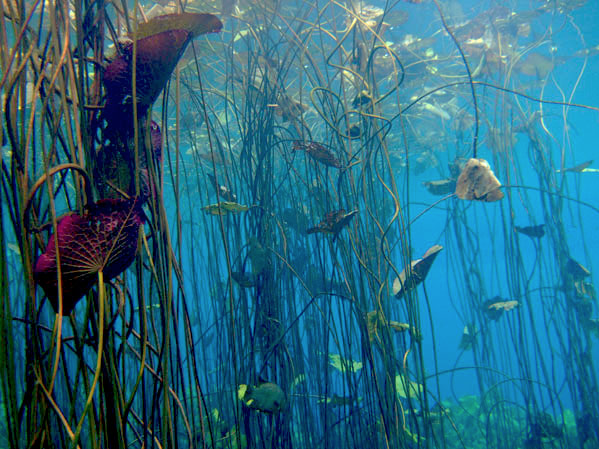
If you are not as fit or experienced, you can also snorkel through Marico Oog. Photo by Marico Oog
This natural spring on Grootfontein farm is a favourite for advanced training and night diving. With a visibility of more than 20 metres on a good day, it’s like immersing yourself in an underwater garden where you can see the water lilies clearly. Temperatures range from 18 to 24 degrees Celsius and it’s almost 14 metres deep. You may see fish such as kurper or bass as well as eels and crabs.
4. Lake Malawi, Malawi
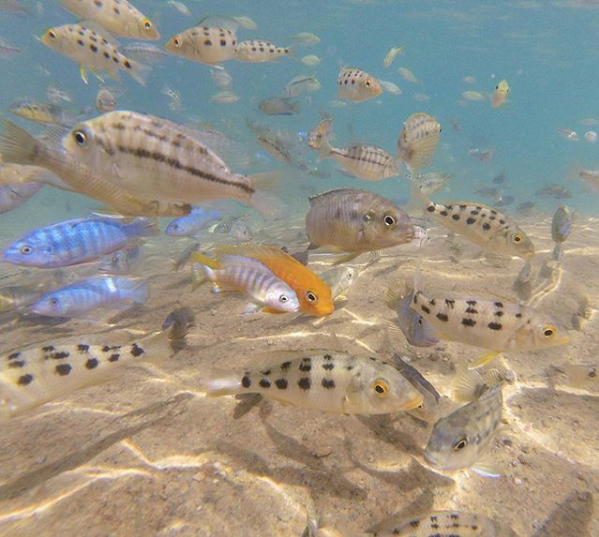
There aren’t too many plants in Lake Malawi due to the water’s high alkalinity. Photo by Amy Maree Fraser
Lake Malawi is the perfect destination for the water sports enthusiast, especially if you intend to go below the surface. The water is warm and clear and there are approximately 1000 species of freshwater fish. Lake Malawi is 700 metres deep, making it one of the deepest lakes in the world. It’s also the eighth largest at 560 kilometres long and 80 kilometres wide. There are various dive sites to explore and these include the Wreck, Bakers Oven, the Canyon, Zimbabwe Rock and the Aquarium. Zimbabwe Rock is particularly suitable for experienced divers because of the drop-offs and swim throughs. The Aquarium is best for inexperienced divers because it is shallow.
Also read: 9 things to do in Southern Malawi (that don’t involve the lake)
5. Anhumas Abyss, Brazil
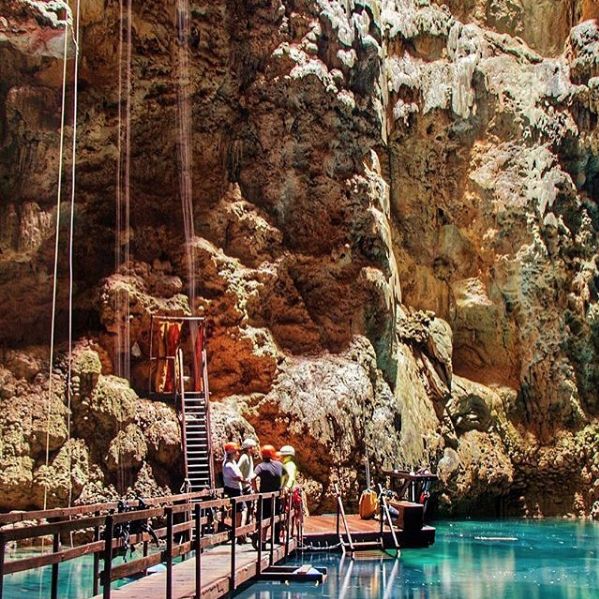
You don’t have to be a diver to enjoy Anhumas Abyss. There are inflatable boat trips on offer as well. Photo by trailfriendssjc
An obscure fracture in the rocks is the ‘doorway’ to an extraordinary subterranean world. Entering Anhumas Abyss is an adrenaline-pumping exercise because you first abseil 72 metres to reach the bottom. Aquamarine colours reflect off the rock formations, limestone cones and the underground lake which is about 80 metres deep. A beam of light descends through the opening above and sometimes causes the water to evaporate, enhancing the mystical element. Anhumas Abyss is restricted to 18 divers and snorkellers and you have to complete a short training programme the day before.
6. Kilsby Sinkhole, South Australia
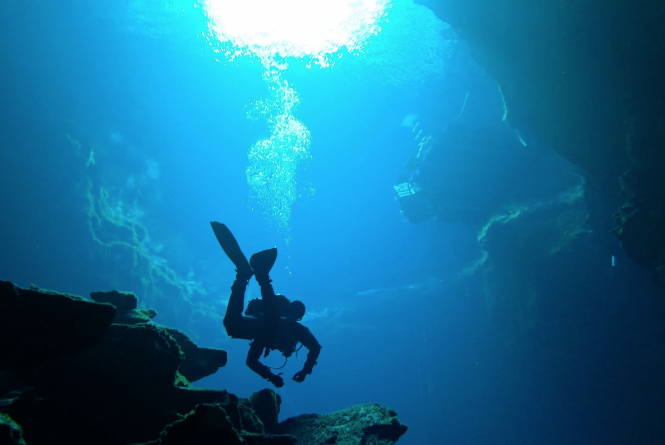
Kilsby Sinkhole is also the training site of the South Australian Police Divers. Photo by Kilsby Sinkhole
The Mount Gambier region in South Australia has a collection of caves and sinkholes, some of which are filled with water. The sea once covered South Australia which led to the formation of limestone. The area is sometimes referred to as the Limestone Coast. When it drained away, rainfall created water-logged tunnels deep in the earth. Kilsby Sinkhole has been a popular diving location since the 1950s and is on a farm. The owner’s grandfather stumbled upon the limestone cavity when he was ploughing the paddock. It is 60 metres deep but divers can only reach depths of 40 metres. The site can only be accessed through an arrangement with Kilsby’s approved operators. Free-divers, snorkellers and recreational scuba divers can dive the open water section.
7. The Cenotes, Mexico

Cenotes can vary in length, width and depth and they are entry points to unexplored cave systems. Photo by Andrea Schaffer
The Cenotes of the Yucatan Peninsula are a geological masterpiece and like most of the freshwater sites on this list, they’re the result of collapsed limestone bedrock. This led to the creation of sinkholes or natural pits and it’s estimated that there are 7000 cenotes. The Mayans relied on them for the water which is fresh because of being filtered through the earth. ‘Cenote’ means ‘sacred well’ and they also had religious importance.
Today, some of the cenotes are natural swimming pools and fascinating cavern and cave diving sites. For divers, open water diving certification is needed and for the caverns, you must be a cavern diver or have full cave diver certification. Some of the popular cenotes are Casa Cenote or Cenote Tankah which has been likened to ‘diving under a tropical rainforest’ and where manatees have been sighted. Dos Ojos, meaning ‘Two Eyes’ is shallow but suitable for divers of all levels. Pet Cemetery is named because of the skeletons and fossils of pre-historic animals. It has caves such as the Blue Abyss and Dark Side of the Moon.
8. Orda Cave, Russia

The cave is called ‘white bride’ because of the chalky colour of the interior. Photo by Orda Cave Awareness Project
The pastures of the Ural Mountains conceal the Orda Cave, underground tunnels that stretch for about five kilometres. Approximately 4,8 kilometres of these are submerged in water. Diving the Orda Cave is reportedly like being suspended in a luminescent, rough diamond because of the gypsum mineral that gives the walls their jagged edges and white colour. The cave is said to be labyrinth-like with 300 million-year-old passages leading in multiple directions. There is visibility of up to 50 metres and water temperatures of between five and six degrees Celsius. Many divers have experienced the dramatic beauty of the Orda Cave but there have been about 300 known deaths. It is a dangerous dive with deep, dark and nauseating twists and turns. It’s a worthy bucket list addition for experienced cave divers.
9. Silfra Frissure, Iceland
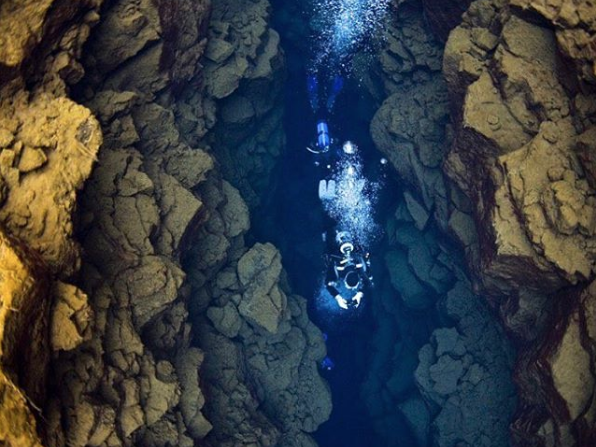
The continental plates drift about two centimetres per year. Photo by ben_s_m
Ever wondered what it could be like to dive between two continental plates? Make your way to Iceland. The Silfra Fissure is a split between the continents of Eurasia and North America and there are four sections: Silfra Hall, Silfra Lagoon, Silfra Big Crack and Silfra Cathedral. The freezing temperatures of two and four degrees Celsius ensures the clearness of the water. Additionally, the water is from glaciers that have been filtered through permeable underground lava. It is 18 metres deep and although you might not go all the way, it is a challenging dive. You can also snorkel in the fissure.
Also read: road tripping Iceland: the frost and the curious
This article, 9 freshwater diving spots you probably didn’t know about, was originally posted on the Getaway Blog by Nandi Majola.